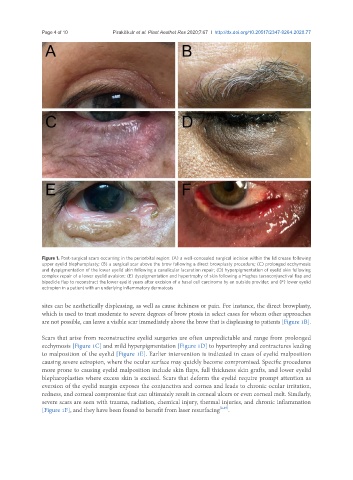Page 790 - Read Online
P. 790
Page 4 of 10 Pirakitikulr et al. Plast Aesthet Res 2020;7:67 I http://dx.doi.org/10.20517/2347-9264.2020.77
Figure 1. Post-surgical scars occurring in the periorbital region: (A) a well-concealed surgical incision within the lid crease following
upper eyelid blepharoplasty; (B) a surgical scar above the brow following a direct browplasty procedure; (C) prolonged ecchymosis
and dyspigmentation of the lower eyelid skin following a canalicular laceration repair; (D) hyperpigmentation of eyelid skin following
complex repair of a lower eyelid avulsion; (E) dyspigmentation and hypertrophy of skin following a Hughes tarsoconjunctival flap and
bipedicle flap to reconstruct the lower eyelid years after excision of a basal cell carcinoma by an outside provider; and (F) lower eyelid
ectropion in a patient with an underlying inflammatory dermatosis
sites can be aesthetically displeasing, as well as cause itchiness or pain. For instance, the direct browplasty,
which is used to treat moderate to severe degrees of brow ptosis in select cases for whom other approaches
are not possible, can leave a visible scar immediately above the brow that is displeasing to patients [Figure 1B].
Scars that arise from reconstructive eyelid surgeries are often unpredictable and range from prolonged
ecchymosis [Figure 1C] and mild hyperpigmentation [Figure 1D] to hypertrophy and contractures leading
to malposition of the eyelid [Figure 1E]. Earlier intervention is indicated in cases of eyelid malposition
causing severe ectropion, where the ocular surface may quickly become compromised. Specific procedures
more prone to causing eyelid malposition include skin flaps, full thickness skin grafts, and lower eyelid
blepharoplasties where excess skin is excised. Scars that deform the eyelid require prompt attention as
eversion of the eyelid margin exposes the conjunctiva and cornea and leads to chronic ocular irritation,
redness, and corneal compromise that can ultimately result in corneal ulcers or even corneal melt. Similarly,
severe scars are seen with trauma, radiation, chemical injury, thermal injuries, and chronic inflammation
[Figure 1F], and they have been found to benefit from laser resurfacing [2,19] .

